Shuttle SN27P2 SFF: AM2 gets the Tiny Treatment
by Jarred Walton on June 30, 2006 11:00 PM EST- Posted in
- Systems
Construction and Assembly
While the external changes are mostly cosmetic, the changes to the internal layout had a bit more of an impact.
The P series featured a mostly tool-less design. You still needed a screwdriver in order to change out the expansion cards and to remove the screws securing the CPU heatsink. Other than those two areas, though, you could completely assemble/disassemble the P series SFFs without touching another tool. In order to address problems some users experienced when transporting their computers, Shuttle has decided to use hard drive trays instead of the mounting rails in the P2 chassis. This means eight screws per hard drive, plus four more for the optical drive, so now it takes a bit more time to assemble a system using the new case. The flip side is that you get a sturdier, more flexible design.
While we never had a problem with the plastic mounting rails, the plastic clips on the drive rails could potentially wear out after frequent hardware swaps, and some users reported that their SATA cables would come loose if they bumped the computer. We're not sure who goes around shaking or dropping their computer anyway, but the end result is that convenience has been slightly sacrificed for compatibility and durability, which isn't a terrible decision on Shuttle's part. (Personally, I still prefer the drive rails, as I'm more likely to swap hardware than to transport a computer, but that's no more representative of the typical computer user than people who attend weekly LAN parties.)
Other than the change from drive rails to the new drive cages, the internals of the P2 chassis are essentially identical to the P series. We did encounter one difficulty with the new layout, though this may be due to the pre-release nature of our test system. The SATA cables have right angle connectors on the hard drive end, and connecting them to the drives requires some bending of the cable as well as a decent amount of effort. The power cables for the hard drives are the same as on the P series, and frankly we wish the SATA cables were the same as well.
Shuttle continues to use their fourth generation Integrated Cooling Engine (4G ICE) for the P2 chassis. The heatsink has a copper base plate with heatpipes connected to a vertical radiator, in addition to a more traditional block of aluminum fins directly above the processor. Two 4-pin temperature controlled fans are used to vent air over this area, the smaller is 70mm in diameter and the larger is 92mm. The PSU also has a fan, and additional cooling at the top-rear of the case is provided by two more 60mm fans. These last two fans also help to cool the hard drive(s), and the BIOS allows you to set the fan speed for these. In practice, the solution continues to work well, though we would prefer a "smart" fan speed option for the rear fans as opposed to a static setting.
The above images basically show the assembly process of our test system. We didn't encounter any difficulties until we came to the DVD drive. Our first attempt at installation resulted in it not lining up properly with the eject button on the front of the case, so we had to remove the drive cages and try again. We also switched to a shorter DVD drive, as the old DVD/CD-RW combo drive shown in the above picture created a very tight fit. We would advise you to install your optical drive with the cage inside the case, as that's the easiest way to make sure everything lines up properly.
Once assembled, the BIOS configuration and operating system installation can proceed. We encountered no difficulties in this area, though if you wish to install to a RAID 0/1 setup you will need to use a floppy disk to provide the necessary drivers.
While the external changes are mostly cosmetic, the changes to the internal layout had a bit more of an impact.
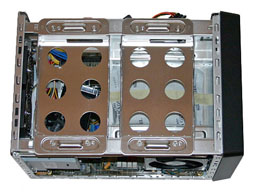 |
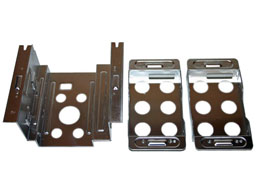 |
| Click to enlarge | |
The P series featured a mostly tool-less design. You still needed a screwdriver in order to change out the expansion cards and to remove the screws securing the CPU heatsink. Other than those two areas, though, you could completely assemble/disassemble the P series SFFs without touching another tool. In order to address problems some users experienced when transporting their computers, Shuttle has decided to use hard drive trays instead of the mounting rails in the P2 chassis. This means eight screws per hard drive, plus four more for the optical drive, so now it takes a bit more time to assemble a system using the new case. The flip side is that you get a sturdier, more flexible design.
 |
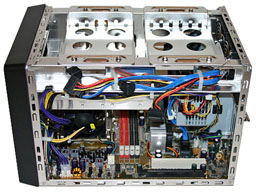 |
| Click to enlarge | |
While we never had a problem with the plastic mounting rails, the plastic clips on the drive rails could potentially wear out after frequent hardware swaps, and some users reported that their SATA cables would come loose if they bumped the computer. We're not sure who goes around shaking or dropping their computer anyway, but the end result is that convenience has been slightly sacrificed for compatibility and durability, which isn't a terrible decision on Shuttle's part. (Personally, I still prefer the drive rails, as I'm more likely to swap hardware than to transport a computer, but that's no more representative of the typical computer user than people who attend weekly LAN parties.)
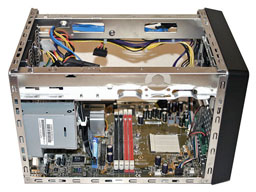 |
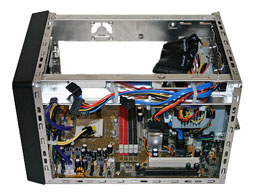 |
| Click to enlarge | |
Other than the change from drive rails to the new drive cages, the internals of the P2 chassis are essentially identical to the P series. We did encounter one difficulty with the new layout, though this may be due to the pre-release nature of our test system. The SATA cables have right angle connectors on the hard drive end, and connecting them to the drives requires some bending of the cable as well as a decent amount of effort. The power cables for the hard drives are the same as on the P series, and frankly we wish the SATA cables were the same as well.
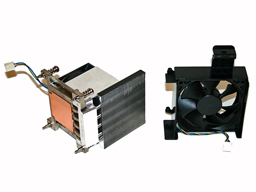 |
 |
| Click to enlarge | |
Shuttle continues to use their fourth generation Integrated Cooling Engine (4G ICE) for the P2 chassis. The heatsink has a copper base plate with heatpipes connected to a vertical radiator, in addition to a more traditional block of aluminum fins directly above the processor. Two 4-pin temperature controlled fans are used to vent air over this area, the smaller is 70mm in diameter and the larger is 92mm. The PSU also has a fan, and additional cooling at the top-rear of the case is provided by two more 60mm fans. These last two fans also help to cool the hard drive(s), and the BIOS allows you to set the fan speed for these. In practice, the solution continues to work well, though we would prefer a "smart" fan speed option for the rear fans as opposed to a static setting.
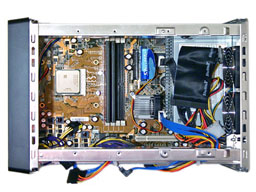 |
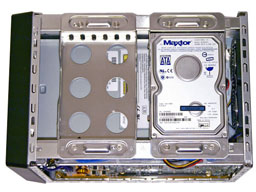 |
| Click to enlarge | |
The above images basically show the assembly process of our test system. We didn't encounter any difficulties until we came to the DVD drive. Our first attempt at installation resulted in it not lining up properly with the eject button on the front of the case, so we had to remove the drive cages and try again. We also switched to a shorter DVD drive, as the old DVD/CD-RW combo drive shown in the above picture created a very tight fit. We would advise you to install your optical drive with the cage inside the case, as that's the easiest way to make sure everything lines up properly.
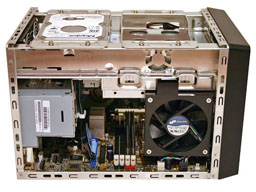 |
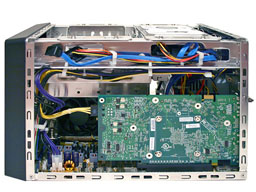 |
| Click to enlarge | |
Once assembled, the BIOS configuration and operating system installation can proceed. We encountered no difficulties in this area, though if you wish to install to a RAID 0/1 setup you will need to use a floppy disk to provide the necessary drivers.










17 Comments
View All Comments
SoSpartan - Tuesday, August 1, 2006 - link
Why do you state that the SN27P2 has a 400W power supply when your pictures clearly show a 350W power supply? Shuttle's website says 400W prominently, but their PDF spec sheet says 350W! What's the deal? The extra 50W could make the difference between running a nVidia 6800 vs 7900GTX or 7950GX2 stably!akp - Sunday, July 2, 2006 - link
Nice review in general, but I feel like there's one thing really missing. As you say on page 6 (Benchmark setup):The key feature for the SN27P2 of course is its size, but noise control is also likely to be a major consideration.
If you are simply planning on using the system as the core of an HTPC, our recommendation would be to grab one of the many fan-less GPUs that are coming to market, probably a 7600 (GT as an upgrade) or an X1600 Pro/XT would strike a decent balance between performance and power/heat requirements.
Given those factors, wouldn't it have made a lot of sense to include a fanless GPU in your benchmark setup? I really have to wonder how much of the power draw and noise was coming just from the graphics card in those tests.
JarredWalton - Sunday, July 2, 2006 - link
Actually, the majority of the noise under full load with the 7600GT comes from the CPU. However, the GPU is contributing a bit in that configuration. A fan-less GPU wasn't included because I don't have one at present. The idle noise with the 7600 GT used is almost entirely generated by the CPU/case cooling - maybe subtract 2 dB for the GPU at best.artifex - Saturday, July 1, 2006 - link
What was the temperature like when all bays were full of either hard drives or an active DVD burner? I'm wondering if it can really keep up in a situation like that. In my tower, my drives seem to get really hot without extra cooling. Please consider adding a test like this the next time you review SFFs.Also, e-SATA sounds cool, but that's strictly a drive interface. Wouldn't another firewire port have been more useful? Is e-SATA faster than FW400? If I use the firewire in the back for one external firewire drive, that means I'm left with a minifw in front for video cameras, etc. I'd really like more flexibility, there, so I'll be looking forward to your reviews of other AM2 SFFs for sure.
JarredWalton - Saturday, July 1, 2006 - link
SATA tops out at 300 MB per second these days (though in reality hard drives can't come near that number for sustained performance). FireWire 1394b tops out at 800 Mbps (one third as fast) and 1394a only hits 400 Mbps. That said, FireWire is a far more flexible interface, as there are many peripherals that use it. So far SATA is only for hard drives.As for installing three HDDs, I'd be very nervous if they were all hot drives. However, I have an SN25P with two HDDs that has been in use for about a year and it has no problems with temperatures. Under the right conditions (or wrong conditions if you prefer), the fans in the case will simply have to spin faster and make more noise. I don't think 51 dB is as loud as the SN25P can get, and the SN27P2 is basically the same in terms of cooling.
Note that the rear of the case does have two 60mm fans just for cooling the HDD area (mostly), so the only HDD spot I'd be concerned with is the floppy/HDD area, and then only if you were planning on running three HDDs along with a big GPU like a 7900 GTX or X1900 XTX. Even then, those large GPUs would probably just end up adding more noise and helping ventilation.
artifex - Monday, July 3, 2006 - link
Well, this might replace my Antex Soho tower with 3 accessory fans, so I'm used to the noise already. Also, I only have a 5500 since I'm not a big gamer, so this is looking better. Thanks again.Howard - Saturday, July 1, 2006 - link
What's an SPL meater?JarredWalton - Saturday, July 1, 2006 - link
Sound Pressure Level. Just a small device to measure how much noise is present. For example, I'm sitting in front of a 24" fan right now, which is rather noisy. It generates 55 dB of noise at a distance of six feet. Scary that some PCs are as loud as a standing fan. :|AnonymouseUser - Saturday, July 1, 2006 - link
What is the point of the last paragraph? This was a decent review until the very end."There are two major events that need to take place before we would recommend most people go out and buy this system, however. First, it needs to be available for purchase"
OK, that makes sense, but that pretty much goes without saying that it needs to be available before you can buy it.
"More importantly, as we've mentioned repeatedly over the past few weeks, you might as well wait a month now and find out what happens with the Core 2 Duo launch. That also gives the side benefit of lower X2 CPU prices, [[ so even if you're not interested in Intel's new processor lineup for whatever reason ]], the AM2 price cuts are likely to keep you waiting another month."
How does this affect the peformance of the SFF in the review? How does this affect the price of the SFF in the review?
This was a review of an AMD based SFF, not a comparison of AMD/Intel cpus, so we don't need your opinion on which CPU brand to choose.
Frumious1 - Saturday, July 1, 2006 - link
OMG Jarred! How DARE you mention crazy things like launch dates and prices cuts. WTF do those have to do with a review about an expensive-ass Shuttle SFF!? We AMD fanboys prefer to bury our heads in the sand and pretend that Core 2 Duo is just a bunch of lies and that AM2 will remain superior until hell freezes over. (Which, incidentally, is scheduled to happen around July 25th last I heard....)Seriously Anonymouse do you work for AMD or something? You many not give a damn about Core 2 Duo, but most of us don't have our blinders on. "How does this affect the peformance of the SFF in the review? How does this affect the price of the SFF in the review?"
I'd say that it means future SFFs like the SD37P2 will offer better performance than anything you can put in the SN27P2 (at least until AMD ships something other than a three-year-old K8 derivative), and it means that for the same $400+ that the Shuttles are going to cost you could end up with a better (faster and cooler running) SFF. Yes I said it: Core 2 Duo will be BETTER than AM2 X2! So stick THAT where the sun don't shine (right next to your head).
Freaking amazing how that thing called logic works, innit?
For the record, I don't work for Intel or AMD, and I wouldn't buy a SFF unless the price was the same as that of an ATX case + mobo + moderate PSU. Just about any reasonable ATX case is going to end up quieter than these SFFs if you build it right.